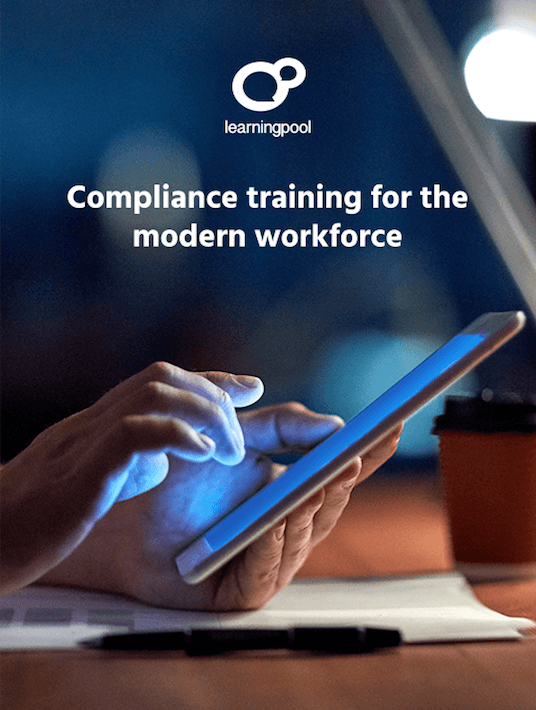Reasons Why Compliance Training Is Vital For The Modern Workplace
Modern workers are expected to be ready to adapt and evolve as the environment around them and their work change. Many of those changes are driven by information technology, which with its prospect of instant access to virtually limitless information, is regarded as a quick and easy enabler of enhanced performance.

But then we need to include compliance in the picture. We expect employees not only to work better, we expect them to work compliantly too. Is it any wonder the modern worker reports feeling overwhelmed and stressed? And is that not becoming a compliance issue too?
Compliance For Compliance Sake?
No-one doubts the need for compliance, but you’d be forgiven for feeling bewildered by what’s involved in being compliant. Many organizations face a constantly changing and ever more complex regulatory and fiscal environment. The reach may be global, but the implementation is further complicated by local regulations and practices.
Then, on an organizational level, there are industry or corporate standards to adhere to, made more involved by the increasing complexity of the products and services that companies offer. Just recently, we’ve had to contend with GDPR. Environmental and sustainable targets also have to be met. For employees, there are compliance issues to be informed about in Health & Safety, Employment Rights, Diversity, Disability, and so on. As the old joke goes, Health and Safety can be a minefield.
The Cost Of Non-Compliance
We all remember stories of big Pharma firms facing crippling fines from the FDA for non-compliant practices. Banking and finance industries have faced comparable actions from financial regulatory bodies around the world. This cost is not just a massive hit to the corporate balance sheet, but also in the reputational damage, these stories inflict.
But there are other costs of non-compliance in the workplace, closer to home, that don’t grab the headlines. Consider an organization that fails to respect employment rights and the damage that causes employee morale. That, in turn, can lead to widespread disaffection leading to increased employee turnover, a fall in performance, a loss of expertise as experienced employees jump ship, and result in difficulties in acquiring the talent to replace them.
The Problem With Compliance Training
The tried and trusted answer to compliance issues is compliance training. This training is often rolled out to the organization as a whole. The problem is that the training isn’t always effective, no matter how many times it’s delivered, and that it generally takes employees away from their work for extended periods of time resulting in an additional cost to the company.
Employees fail to appreciate compliance training regarding it as boring, a waste of time, and—even worse—irrelevant. It’s rather like our attitude to having another annoying update to download on our computers. We don’t know its real value, we’re just waiting impatiently for it to install so we can carry on with (to us) more important tasks.
Compliance training has generally been about checking boxes, a process to be endured not enjoyed. The scatter-gun approach employed by many training departments means that much of the training can be irrelevant to employees sitting the course. And what’s the reward for sitting through compliance training? Generally, another similar course in 6 months’ time.
This traditional approach produces a vicious circle: poorly-delivered, uninspiring training, with minimal impact and retention, leads to ill-prepared employees who require more training.
An Alternative Approach
Clearly, if training is to be the solution to making employees and organizations act compliantly, it needs to be more effective and relevant. One way of making it so is to regard training not as separate, distinct, and episodic, but as a continuous process. And a process that begins in the environment where employees are working, at the point where they need it, on the job. It also means personalizing the learning to suit individual employees.
Furthermore, training needs to instill the belief that working compliantly means working well. Being compliant shouldn’t be a chore, it should be the key to improved performance.
Compliance Training For The Modern Employee
The modern employee has instant access to a variety of sources on information anytime, anywhere just a click away on a smart, mobile device. He or she is used to finding out information in a personalized, engaging, and interactive way. The challenge for L&D in any organization is to make compliance training similarly attractive and easy to access.
Instead of the tick-box approach which requires you to click through a series of screens, take a quick multiple-choice test, and verify this is all your own work, you can make compliance training really relevant and engaging by employing a series of learning stratagems.
For example, you can adopt a gamification approach that challenges learners to reach targets and receive rewards as they progress through various scenarios. Story or scenario-based exercises help drive home the personal relevance of compliance as they’re targeted to an individual’s role or job. This form of personalization recognizes that not everyone needs the same level or aspects of compliance training. If you’re in Sales, you may have different knowledge of compliance issues to someone in HR, for example.
Making Compliance Accessible
Break up the training into bite-sized chunks. Instead of entire training courses, think of a bank of resources that can be consulted when and where an employee needs them. This encourages employees to be responsible for their own compliance and increases the sense of relevance by tying compliance training to their working practices.
With modern, AI-Virtual Assistants, like a learning chatbot, you can have compliance resources available on demand, 24/7. A chatbot can notify employees of changes in compliance training, on the need for a piece of refresher training, can respond to learner inquiries, and act as a mentor in the onboarding process for new employees.
This approach to compliance training takes it into the workflow, making it part of the working experience and therefore giving it more impact and effect.
Knowing What They Don’t Know
One of the benefits of deploying an AI-powered chatbot for compliance is that it can give you vital feedback that allows you to close gaps in compliance training and observance. It can record interactions with learners, so L&D can have hard data on which resources are being accessed and which aren’t. Also, it’ll record where it doesn’t have the answer, highlighting a gap in your knowledge provision.
By knowing what you don’t know or what training resources people are avoiding, you can better target your compliance training, making it more relevant to employee roles and filling potentially costly gaps.
Compliance Training In The Modern Workplace
The key to effective, modern compliance training is situating it squarely in the workflow. We need to overcome the perception that compliance training is just an add-on and something to be avoided or ignored if possible. If we bring compliance training into the real working environment and make resources available in the place people work (office, factory, on the road and so on) and accessible while they’re working, it becomes part of the job role.
Being compliant then becomes best practice. Training is no longer abstract and distant. Instead, employees see and feel the benefits.
Brought into the workflow and directed at the needs of the modern learner, compliance training can show that being compliant isn’t just a necessary evil, it’s the way to work safer, smarter, and more efficiently. It’s integral to the better performance.
Sources:
- 6 Key Elements A Modern Compliance Training Requires For Behavior-Changing Results
- The Challenges of Delivering Compliance Training
- Solving the compliance training conundrum: 3 things you can do today
- Different Types of Compliance that Affect Business Owners








